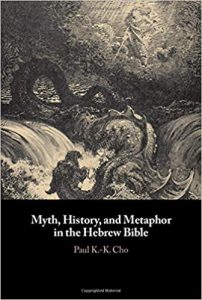O artigo
Myth as Story and Metaphor in the Hebrew Bible
By Paul K.-K. Cho – The Bible and Interpretation: June 2019
I. Introduction
Allow me to begin with a bold claim that I can only begin to defend in this blog: Myth constitutes a vital part of the Hebrew Bible; it powerfully shapes the contours of biblical language, its various narratives, and theologies. That is, myth deeply defines what we might call the biblical world – populates the landscape with mythic monsters and deities and animates that world in which the God of Israel rises against forces of evil and, through victorious battle, creates order, erects his temple, and establishes his kingship.
Some readers will find the above claim objectionable. For example, some may argue that the Hebrew Bible is itself polemical against myth and instead espouses monotheism and a historical conception of reality. Yhwh, the God of Israel, the argument might go, says, “I am the First, and I am the Last; there is no god but me” (Isa 44:6). If there is but one God according to the Hebrew Bible, how can it contain myths with their many gods? And Yhwh delivers Israel in historical time, out of slavery, out of Egypt. If God acts in history, what need is there for myth?
Yet, we find fragments of myth throughout the pages of the Hebrew Bible, interwoven into genuine memories of the past, faithful representations of the present, and sincere hopes for the future. What more? Careful study reveals that myth shapes the biblical view of history in toto and thus the very reality in and through and toward which biblical writers lived. That is, we find that myth in the Hebrew Bible has not only to do with expression but also with being. Myth, it can be argued, constitutes a vital, even a foundational, part of the Hebrew Bible and the biblical world.
(…)
VII. Conclusion
That fragments of myth can be found in the Hebrew Bible is clear to anyone who has read it. That these fragments in fact give shape to the narrative plot of pivotal moments in the Hebrew Bible may come as a surprise to some. What more, we have only begun to understand the ways in which myth animates the biblical vision of the world – the foundational events of creation and exodus and the ongoing hope for redemption out of the conditions of exile and the cataclysm of the eschaton.
O livro
CHO, P. K.-K. Myth, History, and Metaphor in the Hebrew Bible. Cambridge: Cambridge University Press, 2019, 259 p. – ISBN 9781108476195
This book examines the long-debated issue of the relationship between the Hebrew Bible and ancient Near Eastern myths. Using an innovative, interdisciplinary  methodology that combines theories of metaphor and narrative, Paul Cho argues that the Hebrew Bible is more deeply mythological than previously recognized. Because the Hebrew Bible contains fragments of the sea myth but no continuous narrative, the study of myth in the Hebrew Bible is usually circumscribed to the level of motifs and themes. Cho challenges this practice and demonstrates that the Hebrew Bible contains shorter and longer compositions studded with imagery that are structured by the plot of sea myths. Through close analysis of key Near Eastern myths and biblical texts, Cho shows that myth had a more fundamental influence on the plot structure and conceptual framework of the Hebrew Bible than has been recognized.
methodology that combines theories of metaphor and narrative, Paul Cho argues that the Hebrew Bible is more deeply mythological than previously recognized. Because the Hebrew Bible contains fragments of the sea myth but no continuous narrative, the study of myth in the Hebrew Bible is usually circumscribed to the level of motifs and themes. Cho challenges this practice and demonstrates that the Hebrew Bible contains shorter and longer compositions studded with imagery that are structured by the plot of sea myths. Through close analysis of key Near Eastern myths and biblical texts, Cho shows that myth had a more fundamental influence on the plot structure and conceptual framework of the Hebrew Bible than has been recognized.
Paul K.-K. Cho is an assistant professor of Hebrew Bible at Wesley Theological Seminary, Washington, DC. His interests center on the interpretation of the Hebrew Bible, with emphasis on its literary texture and modes of producing meaning, particularly as they relate to the innovation and creation of worldviews and theologies.